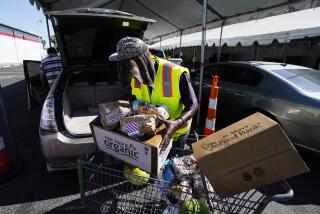Food stamps buy up to $2.1 billion a year in sugary drinks, study says
- Share via
The federal food assistance program SNAP pays $1.7 billion to $2.1 billion for purchases of sugar-sweetened beverages every year, a new study has found.
Meanwhile, the government’s Dietary Guidelines for Americans recommend that we cut back on consumption of sugary drinks.
A disconnect? The authors seem to think so.
Supplemental Nutrition Assistance Program benefits are important, they stress, but “allowing annual use of multibillions of SNAP benefits to purchase products that are at the core of public health concerns about obesity and chronic illnesses appears misaligned with the goals of helping low-income families live active, healthy lives.”
They suggest that reauthorization of the SNAP program, set for later this year, “could be a good time to reconsider the program priorities to align use of public funds with fostering public health.”
The study, published in the American Journal of Preventive Medicine (it is to be up on the journal’s website soon), was conducted by researchers at Yale University. It used data from supermarket loyalty cards to identify the purchase patterns of grocery shoppers enrolled in WIC (the Women, Infants and Children federal food program), many of whom were also enrolled in SNAP, the federal food stamp program. The number-crunched data involved 39,172 New England households making purchases from January 2011 to June 2011.
The findings: For those households participating in SNAP, 58% of the “refreshment beverages” purchased were sugar-sweetened drinks, mostly paid for by SNAP. (Refreshment beverages included carbonated soft drinks, bottled water, 100% juice, fruit drinks, energy drinks and shots, sports drinks, ready-to-drink tea, flavored/enhanced water, ready-to-drink coffee and powdered non-alcoholic drinks.)
The authors, led by Tatiana Andreyeva of Yale’s Rudd Center for Food Policy and Obesity, then used the data to extrapolate to the rest of the country and for an entire year. That’s how they arrived at the $1.7 billion- to $2.1 billion-a-year figure for purchases of sugar-sweetened beverages by those enrolled in SNAP.
They think that may be an underestimate, if anything. That’s because consumption of sugary soft drinks is lower in New England than in many other parts of the country and because soft-drink consumption is likely to go up during the hot summer months, which were not within the time period assessed.
In a commentary accompanying the journal article, Barbara Laraia of the UC Berkeley School of Public Health writes that restricting the ability to buy sugary drinks through SNAP is not necessarily a good idea.
“Restrictions on soda purchases would not achieve their goal if participation rates declined or if soda purchases were replaced with purchases of other energy-dense foods,” she wrote. “A second major criticism affecting restrictions on SNAP benefits is that these send a paternalistic message: that it is OK to restrict what poor Americans purchase with federal dollars, presumably because they do not know any better.”
Read our science blog at latimes.com/sciencenow and our health blog at latimes.com/boostershots.
twitter.com/@LATimesRosie






